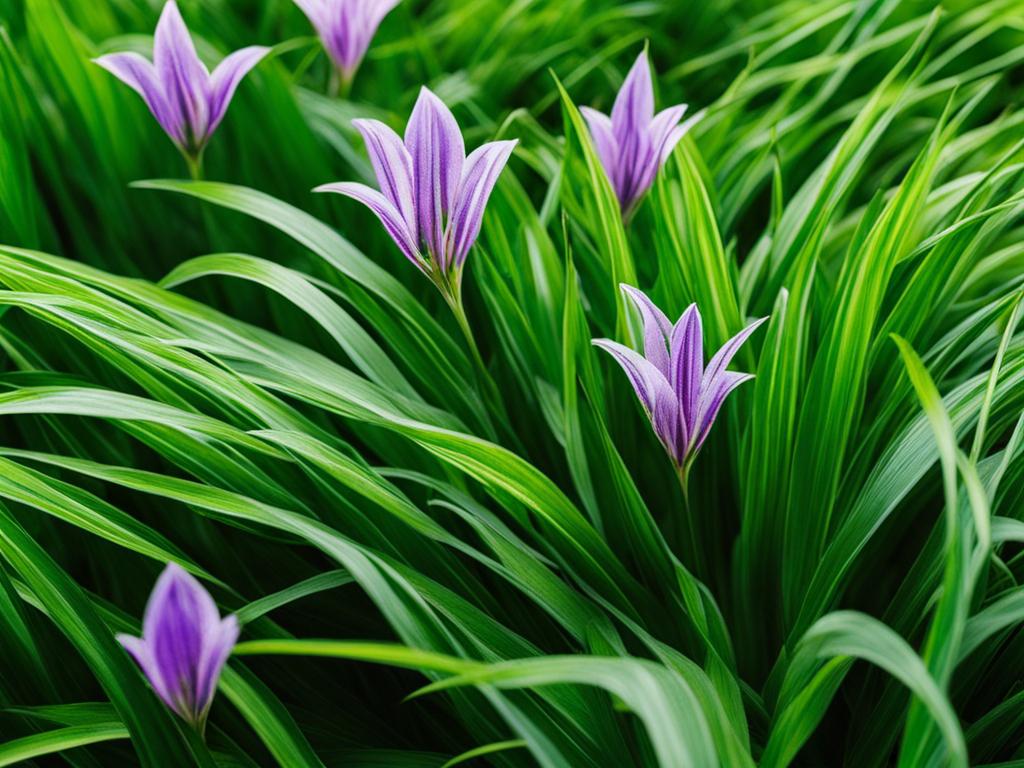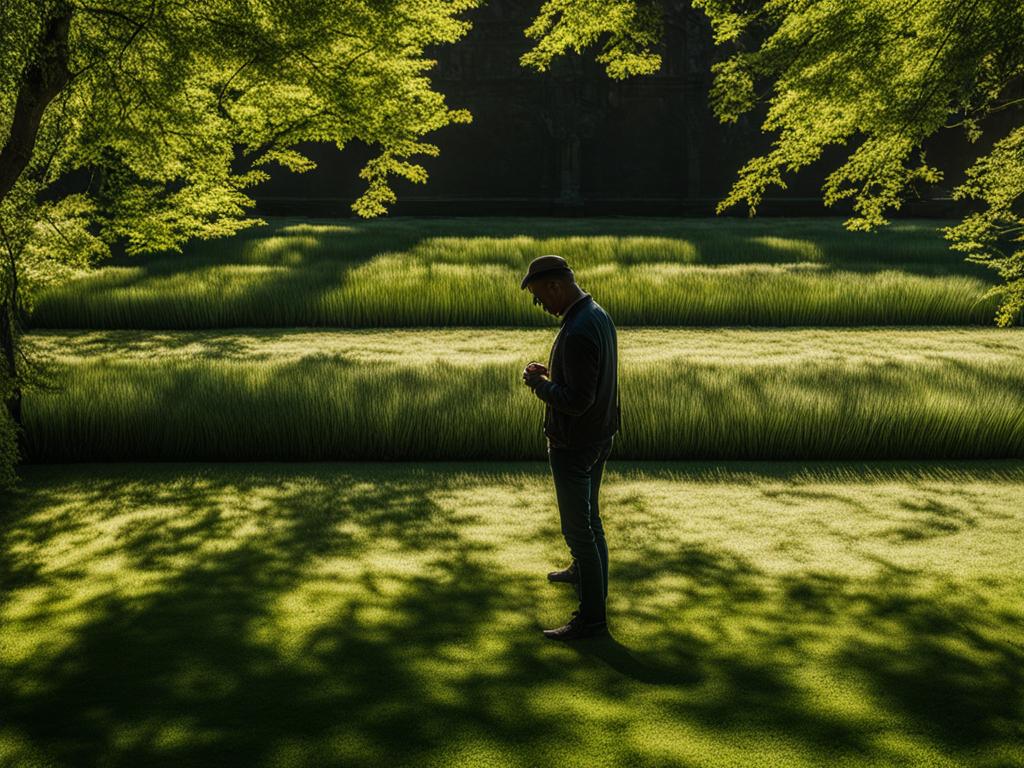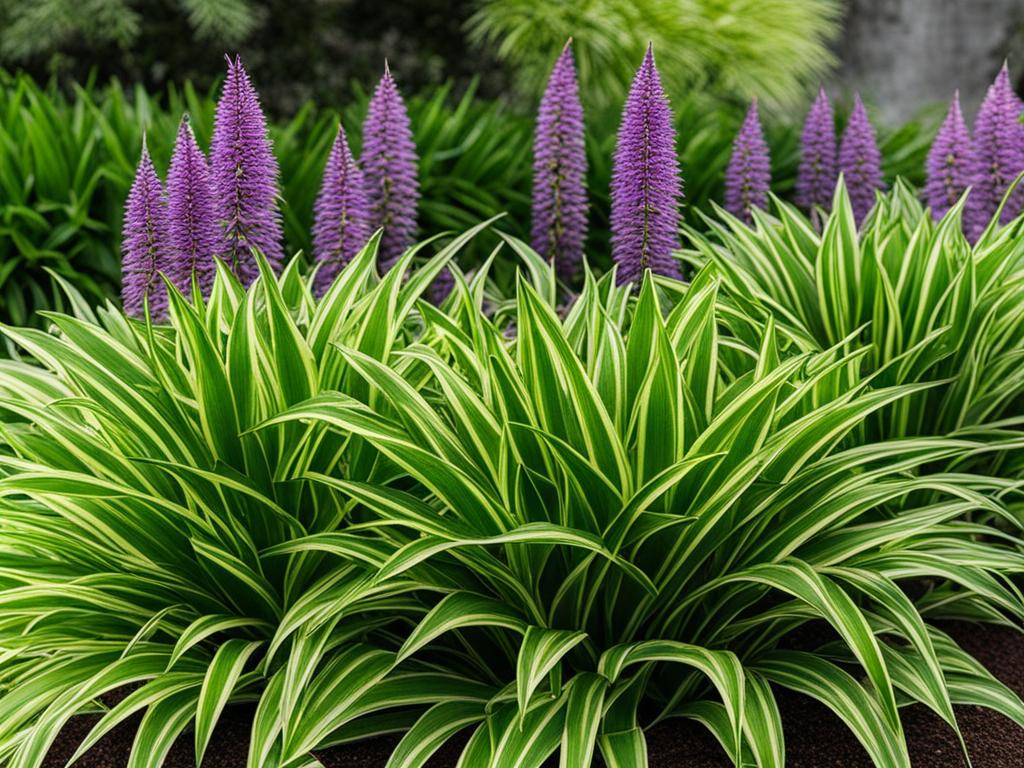Mondo grass and monkey grass may appear similar at first glance, but there are distinct differences between the two. Both plants are commonly used as ground cover and border plants, but understanding their characteristics is essential for choosing the right option for your landscaping needs.
Key Takeaways:
- Mondo grass and monkey grass have different leaf widths.
- Mondo grass spreads through underground runners, while monkey grass grows in clumps.
- Monkey grass is hardier during winter compared to mondo grass.
- Mondo grass produces bright blue berries, while monkey grass has black berries.
- Both plants can be used as ground cover and border plants.
Characteristics of Mondo Grass
Mondo grass, scientifically known as Ophiopogon japonicus, is an evergreen, sod-forming perennial that adds beauty and texture to any landscape. With its tufted, grass-like plants reaching a height of 8 to 16 inches, mondo grass is a versatile and popular choice for both residential and commercial gardens.
The leaves of mondo grass are narrow, dark green, and fine to medium in texture, providing a striking contrast against other plants and flowers. This grass also boasts white or lilac-tinged flowers that bloom from July to September, adding a touch of color and elegance to the garden.
One of the standout features of mondo grass is its bright blue berries that follow the flowering period. These berries not only enhance the visual appeal but also attract wildlife, making mondo grass a favorite among nature enthusiasts.
Due to its low-growing habit and ability to form dense clumps, mondo grass is an excellent choice for ground cover, borders, rock gardens, and shady areas. It effortlessly fills in empty spaces and creates a uniform, polished appearance in any landscape.
“Mondo grass is a versatile and popular choice for both residential and commercial gardens.”
Not only is mondo grass visually appealing, but it is also easy to maintain once established. It prefers moist soil and can tolerate filtered sun to full shade, making it an ideal option for areas with limited sunlight. The resilient nature of mondo grass ensures a lush, green look year-round with minimal effort.
To summarize, the key characteristics of mondo grass include:
- Narrow, dark green leaves
- Tufted, grass-like plants
- White or lilac-tinged flowers
- Bright blue berries
- Low-growing habit
- Well-suited for ground cover and borders
- Tolerates filtered sun to full shade
- Requires minimal maintenance
Take a look at the image below to get a visual representation of mondo grass:

| Characteristics of Mondo Grass | Description |
|---|---|
| Scientific Name | Ophiopogon japonicus |
| Height | 8 to 16 inches |
| Leaf Color | Dark green |
| Leaf Texture | Fine to medium |
| Flower Color | White or lilac-tinged |
| Berry Color | Bright blue |
| Preferred Growing Conditions | Moist soil, filtered sun to full shade |
| Common Uses | Ground cover, borders, rock gardens, shady areas |
Characteristics of Monkey Grass
Monkey grass, also known as liriope, is a popular plant belonging to the lily family. Pronounced as luh-rahy-uh-pee, it offers unique characteristics that distinguish it from mondo grass. Let’s explore the key features of monkey grass:
- Broader Leaves: Unlike mondo grass, monkey grass has broader leaves that impart a lush and vibrant appearance to the plant.
- Hardiness in Winter: Monkey grass is known for its resilience during winter months. Its ability to withstand freezing temperatures and maintain its green foliage makes it an excellent choice for colder climates.
- Clumping Growth Pattern: Monkey grass grows in clumps, forming dense tufts of foliage that create an appealing visual impact in gardens and landscapes.
- Showy Flower Stalks: One of its distinguishing features is the production of showy flower stalks that extend above the foliage, adding a touch of elegance to the plant.
- Visible Flowers: Unlike mondo grass, where the flowers are often hidden, monkey grass showcases its blooms, allowing them to be easily observed.
- Black Berries: After flowering, monkey grass develops small black berries, which provide an additional element of interest to the plant.
Monkey grass is a versatile plant that serves multiple purposes in landscaping. Its typical applications include:
- Ground cover
- Border plants
- Landscaping paths
- Stepping stones
- Rock gardens
With its adaptability to various soil conditions and low maintenance requirements, monkey grass can thrive in different environments, making it a popular choice among garden enthusiasts.
A Comparison of Mondo Grass and Monkey Grass
| Attributes | Mondo Grass | Monkey Grass (Liriope) |
|---|---|---|
| Leaf Width | Narrow | Broader |
| Winter Hardiness | Susceptible to discoloration and damage | More hardy, maintains green foliage |
| Growth Pattern | Spreads through underground runners | Forms clumps |
| Flower Stalks | Often hidden beneath foliage | Extend above the foliage, showy |
| Berries | Bright blue | Black |
In summary, monkey grass, or liriope, offers distinct characteristics that set it apart from mondo grass. With its broader leaves, hardiness in winter, clumping growth pattern, showy flower stalks, and visible flowers, it brings a unique charm to any garden or landscape. Consider incorporating monkey grass into your outdoor space to add beauty, texture, and year-round interest.
Choosing Between Mondo Grass and Monkey Grass
When deciding between mondo grass and monkey grass, it’s important to consider your specific landscaping needs. Both options have their unique advantages and can enhance the aesthetics of your outdoor space. Let’s explore the benefits of using mondo grass and monkey grass, so you can make an informed decision.
Mondo Grass: A Lush and Drought-Resistant Option

Mondo grass is an excellent choice if you’re looking for a plant that can withstand drought conditions and still maintain its lush appearance year-round. Its fine-textured leaves and tufted growth habit create a dense ground cover that adds elegance to any landscaping project.
“Mondo grass is perfect for areas with filtered sun or full shade. Its ability to thrive in shaded environments makes it an attractive option for gardens with limited sunlight exposure.”
Additionally, mondo grass is known for its minimal maintenance requirements once established. Its hardy nature and adaptability to different environmental conditions make it a versatile option for various landscaping projects.
Monkey Grass: Hardy and Beautifully Showy
Monkey grass, also known as liriope, offers a hardier alternative with a touch of showiness. Its broader leaves and quick growth make it an ideal choice for those seeking a resilient ground cover option.
“Monkey grass is perfect for landscapes with various soil conditions, adding a pop of color with its visible flower stalks that surpass the foliage height.”
Monkey grass is well-suited for cutting back if it starts to encroach on other plants or areas of your garden. This quick ability to rejuvenate and fill in spaces provides a dynamic and ever-changing landscape, adding interest and allure to your outdoor environment.
The Benefits of Using Mondo Grass and Monkey Grass
Both mondo grass and monkey grass offer several benefits beyond their aesthetic appeal. Here are a few of their advantages:
- Reduced lawn maintenance: By using mondo grass or monkey grass as ground covers or borders, you can minimize the time and effort required for lawn maintenance.
- Year-round appeal: Mondo grass maintains its lush appearance throughout the year, while monkey grass provides a vibrant and showy display with its flowers and foliage.
- Versatility: Both plants are versatile and can adapt to different soil conditions, making them suitable options for a variety of landscaping projects.
Regardless of your choice between mondo grass and monkey grass, you can create a visually appealing and low-maintenance landscape that suits your specific needs.
Key Similarities and Dissimilarities Between Mondo Grass and Monkey Grass
While mondo grass and monkey grass share similarities as ground cover and border plants, there are important distinctions between the two. Mondo grass has narrower leaves, produces bright blue berries, and is less susceptible to winter discoloration and damage from insects and diseases. Monkey grass, or liriope, has wider leaves, black berries, and showy flower stalks that exceed the foliage height. It requires an annual cutback for optimal growth. Understanding these differences is crucial for selecting the right plant for your landscaping goals.
Similarities:
- Both mondo grass and monkey grass can be used as ground cover and border plants.
Dissimilarities:
| Mondo Grass | Monkey Grass (Liriope) |
|---|---|
| The leaves are narrower. | The leaves are wider. |
| Produces bright blue berries. | Produces black berries. |
| Less susceptible to winter discoloration and damage from insects and diseases. | More hardy during winter. |
| Produces showy flower stalks that exceed the foliage height. | |
| Requires an annual cutback for optimal growth. |
To visually represent the differences between mondo grass and monkey grass, refer to the table below:
Conclusion
When it comes to choosing between mondo grass and monkey grass, several factors should be considered, including desired appearance, hardiness, and maintenance requirements. Mondo grass is an excellent choice for those seeking a year-round lush appearance, as it maintains its vibrant green color throughout the seasons. It is also a drought-resistant plant, making it ideal for areas that receive less water. With its minimal maintenance needs, mondo grass is perfect for those seeking a low-maintenance landscaping option.
On the other hand, if you prefer a plant that quickly fills in spaces and provides a touch of showiness, monkey grass, also known as liriope, is the better option for you. It features broader leaves and showy flower stalks that extend above the foliage, adding a pop of color to your garden. Monkey grass is hardy during the winter season, making it a reliable choice for areas that experience harsh weather conditions.
Ultimately, the choice between mondo grass and monkey grass depends on your specific landscaping needs and preferences. Consider factors such as the desired appearance, the level of maintenance you are willing to commit to, and the climatic conditions of your area. Both options offer attractive ground cover and border solutions, enhancing the beauty of your outdoor space. Choose the plant that aligns best with your garden design goals and enjoy the benefits it brings to your landscape.
FAQ
What are the key differences between mondo grass and monkey grass?
Mondo grass has narrower leaves and produces bright blue berries, while monkey grass has wider leaves and produces black berries. Mondo grass is less susceptible to winter discoloration and damage from insects and diseases compared to monkey grass.
What are the characteristics of mondo grass?
Mondo grass is an evergreen, sod-forming perennial with tufted, grass-like plants. It has narrow, dark green leaves and reaches a height of 8 to 16 inches. Mondo grass produces white or lilac-tinged flowers from July to September, followed by bright blue berries. It prefers moist soil and can tolerate filtered sun to full shade.
What are the characteristics of monkey grass?
Monkey grass, also known as liriope, has broader leaves compared to mondo grass. It grows in clumps and produces showy flower stalks that extend above the foliage. Monkey grass berries are black in color. It can thrive in various soil conditions and requires an annual cutback for optimal growth.
How do I choose between mondo grass and monkey grass?
When choosing between mondo grass and monkey grass, consider factors such as desired appearance, hardiness, and maintenance requirements. Mondo grass offers a year-round lush appearance, drought resistance, and minimal maintenance. Monkey grass, or liriope, provides broader leaves, showy flower stalks, and the ability to quickly fill in spaces.
What are the key similarities and dissimilarities between mondo grass and monkey grass?
Mondo grass and monkey grass are both used as ground cover and border plants. However, mondo grass has narrower leaves, produces bright blue berries, and is less susceptible to winter discoloration and damage from insects and diseases. Monkey grass, or liriope, has wider leaves, black berries, and showy flower stalks that exceed the foliage height.
